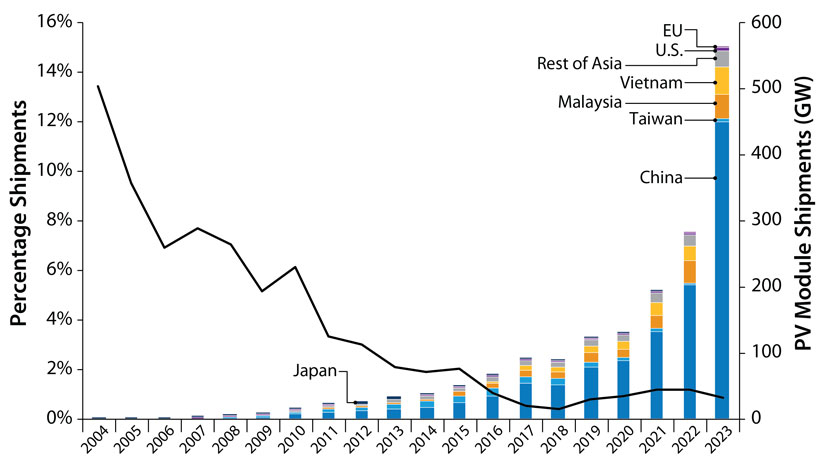The year 2023 marked a pivotal moment in the solar power sector, according to National Renewable Energy Laboratory (NREL) analyst David Feldman.
NREL’s Quarterly Update: A Comprehensive Resource
Every quarter, Feldman and a team of analysts and data specialists from NREL and the U.S. Department of Energy (DOE) gather data for NREL’s Quarterly Solar Industry Update.
Now in its 15th year, this report has evolved from a modest summary for the DOE about a then-niche market to a comprehensive presentation on one of the most rapidly expanding sources of clean energy, both domestically and internationally.
“The difference between the analyst projections we compiled in 2009 and the current landscape is astounding,” Feldman noted. “Solar has transformed from a niche electricity source to a major player in the energy ecosystem, not just for clean power but for the entire energy sector.”
A key strength of the quarterly update lies in its utilization of publicly available industry data from various sources, making this information more accessible to stakeholders.
The Quarterly Solar Industry Update offers analysis, visualizations, and contextualization on a wide range of topics, from solar photovoltaic (PV) module production and supply chains to electricity generation and end-use data. The 2023 data reveals impressive growth both retrospectively and prospectively.
A Snapshot of the Numbers
The Spring 2024 edition of the Quarterly Solar Industry Update provides a comprehensive overview of the solar market’s performance in 2023 and forecasts potential developments from 2024 through 2050.

Based on International Energy Agency reports, global PV installations surged dramatically, with up to 446 gigawatts of direct current (GWdc) connected. Globally, analysts predict that as much as five terawatts (TWdc) of PV may be installed by 2030, and up to 15 TWdc by 2050.

This represents a 66% increase in generation capacity compared to all existing electric generation assets worldwide. Such a vast amount of energy could power approximately 200 LED lightbulbs for every person on Earth simultaneously.
Global and U.S. PV Capacity Additions
China led the world in PV deployment, accounting for roughly 60% of new installations, while the United States secured the second-largest share of PV installations last year.
“Over the past 15 years, China has evolved from a manufacturing leader to dominating numerous segments of the solar supply chain and becoming the primary market for solar deployment,” Feldman observed.
In the U.S., domestic PV deployment reached unprecedented levels, accounting for more than half of new electricity generation capacity in 2023, with 32-40 GWdc of PV installed, depending on installation date definitions.
Module Prices and Global Shipments
The recent decline in global module prices appears to have stabilized. In the first quarter of 2024, these prices remained around 11 cents per Wdc. However, in the United States, average module prices dropped by approximately 5% in the fourth quarter of 2023 but remained about 140% higher than global pricing, at 31 cents per Wdc.

The year 2023 was also a significant year for PV manufacturing and shipping. Global shipments doubled compared to 2022, reaching approximately 564 GW of PV modules shipped, according to Solar PV Market Research.
The United States produced about 7 GW of PV modules last year, while imports increased by 87% from 2022, totaling 55.6 GWdc, according to U.S. Census data.
“We’re at a historic juncture where solar, wind, and batteries are being installed at record levels, signifying a fundamental shift in the future composition of the grid,” Feldman stated.
Data-Driven Decision-Making
Historically, the Quarterly Solar Industry Update has provided a detailed look at the solar industry for both DOE and industry stakeholders, including grid planners and developers. Now, through NREL’s new interactive data platform, readers can generate their own analyses and visualizations of the data, tailored to their specific needs.
“It has evolved from a one-way conversation to a format that empowers stakeholders to interact with the data, examining long-term trends and focusing on what matters most to them,” explained Jarett Zuboy, an author of the update.
The Quarterly Solar Industry Update offers detailed, publicly available, solar-specific information on a regular basis, equipping stakeholders at all levels, from small solar operators to state and federal entities, with a means to better comprehend the current state and trends within the industry.
“Having a thorough understanding of the current landscape is crucial because there’s a lot of misinformation out there,” Feldman said. “The choices we make now will have lasting consequences for the future.”